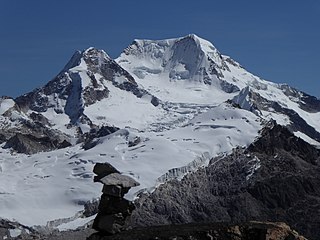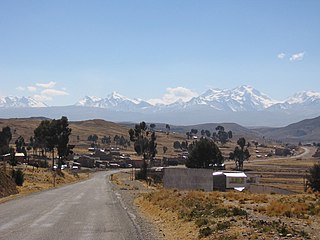| Pico El Toro | |
|---|---|
| Highest point | |
| Elevation | 4,755 m (15,600 ft) |
| Coordinates | 8°21′00″N71°15′00″W / 8.35000°N 71.25000°W Coordinates: 8°21′00″N71°15′00″W / 8.35000°N 71.25000°W |
| Geography | |
| Location | Mérida, Venezuela |
| Parent range | Sierra Nevada, Andes |
| Climbing | |
| Easiest route | Loma Redonda and Los Nevados |
Pico El Toro is a mountain in the Andes of Venezuela. It has a height of 4755 metres.

The Andes, Andes Mountains or Andean Mountains are the longest continental mountain range in the world, forming a continuous highland along the western edge of South America. The range is 7,000 km (4,350 mi) long, 200 to 700 km wide, and has an average height of about 4,000 m (13,123 ft). The Andes extend from north to south through seven South American countries: Venezuela, Colombia, Ecuador, Peru, Bolivia, Chile, and Argentina.

Viscachas or vizcachas are rodents of two genera in the family Chinchillidae. They are native to South America and look similar to, but are not closely related to, rabbits. The viscacha looks much like a rabbit due to convergent evolution.

Uruguayan Air Force Flight 571, later known as Andes flight disaster, Miracle Flight 571, and The Miracle of the Andes, was a chartered flight that originated in Montevideo, Uruguay, bound for Santiago, Chile. On October 13, 1972, while crossing the Andes, the inexperienced co-pilot of the Fairchild FH-227D, who was the pilot flying, mistakenly believed they had reached Curicó, despite instrument readings that indicated otherwise. The aircraft began descending too early to reach Pudahuel Airport and struck a mountain, initially shearing off both wings and the tail section. The remaining portion of the fuselage slid down the mountain about 725 metres (2,379 ft) before striking ice and snow on a glacier. The flight was carrying 45 passengers and crew, including 19 members of the Old Christians Club rugby union team, along with their families, supporters, and friends.

The Andean states are a group of nations in South America connected by the Andes mountain range. "Andean States" is sometimes used to refer to all seven countries that the Andes runs through, regions with a shared culture primarily spread during the times of the Inca Empire, or it can be used in a geopolitical sense to designate countries in the region that are members of the Andean Community trade group and have a local cultural orientation.

Nevado Ojos del Salado is an active stratovolcano in the Andes on the Argentina–Chile border and the highest active volcano in the world at 6,893 m (22,615 ft). It is also the second highest mountain in both the Western Hemisphere and the Southern Hemisphere behind Aconcagua at approximately 7,000 meters (23,000 ft) and it is the highest in Chile. Nevado Ojos del Salado could be translated as "Eyes of the Salty One", which describes it as being very snowy in the winter and salty with many lakes.

Antisana is a stratovolcano of the northern Andes, in Ecuador. It is the fourth highest volcano in Ecuador, at 5,753 metres (18,875 ft), and is located 50 kilometres (31 mi) SE of the capital city of Quito.

Tupungato, one of the highest mountains in the Americas, is a massive Andean lava dome dating to Pleistocene times. It lies on the border between the Chilean Metropolitan Region and the Argentine province of Mendoza, about 100 km (62 mi) south of Aconcagua, the highest peak of both the Southern and Western hemispheres. Immediately to its southwest is the active Tupungatito volcano, which last erupted in 1987.

The Cordillera Oriental is the widest of the three branches of the Colombian Andes. The range extends from south to north dividing from the Colombian Massif in Huila Department to Norte de Santander Department where it splits into the Serranía del Perijá and the Cordillera de Mérida in Venezuelan Andes. The highest peak is Ritacuba Blanco at 5,410 m (17,750 ft) in the Sierra Nevada del Cocuy.

The Andean natural region, located in central Colombia, is the most populated natural region of Colombia. With many mountains contains the majority of the country's urban centers. They were also the location of the most significant pre-Columbian indigenous settlements. Beyond the Colombian Massif in the south-western departments of Cauca and Nariño, the Colombian Andes divide into three branches known as "cordilleras" : the West Andes run adjacent to the Pacific coast and is home to the city of Cali. The Central Andes run up the center of the country between the Cauca and Magdalena river valleys and includes the cities of Medellín, Manizales and Pereira. The East Andes extend northeast towards the Guajira Peninsula, and includes the cities of Bogotá, Bucaramanga and Cúcuta.

The Dry Andes is a climatic and glaciological subregion of the Andes. Together with the Wet Andes it is one of the two subregions of the Argentine and Chilean Andes. The Dry Andes runs from the Atacama Desert in northern Chile and Northwest Argentina south to a latitude of 35°S in Chile. In Argentina the Dry Andes reaches 40°S due to the leeward effect of the Andes. According to Luis Lliboutry the Dry Andes can be defined by the distribution of penitentes. The southernmost well developed penitentes are found on Lanín Volcano.

Chachacomani is a mountain in the Cordillera Real of the Andes Mountains, east of Lake Titicaca in Bolivia.

Chearoco, Chiaraco or Chiaroco is a mountain in the Cordillera Real in the Andes of Bolivia. It has a height of about 6,127 m (20,102 ft). It is situated in the La Paz Department, Larecaja Province, Guanay Municipality, southeast of the peak of Aman Pata. Chearoco lies between Qalsata in the northwest and Chachakumani in the southeast.

Jachacunocollo, also known as Jacha Cuno Collo, Tres Marias, Don Luis or Jacha Collo is a mountain in the Andes in Bolivia. It is the highest elevation in the Quimsa Cruz Range reaching an elevation of about 5,800 metres (19,029 ft). Jachacunocollo is situated in the La Paz Department, Inquisivi Province, Quime Municipality, north-west of Wayna Khunu Qullu, the second highest mountain in this mountain range.

Wayna Khunu Qullu or Wayna Khunuqullu is one of the highest peaks in the Kimsa Cruz mountain range in the Andes of Bolivia. Its summit reaches about 5,640 metres (18,504 ft) above sea level.

Sirk'i Qullu is a mountain in the Cordillera Real in the Andes of Bolivia, about 5,546 m (18,196 ft) high. It is located in the La Paz Department, at the border of the Pedro Domingo Murillo Province, La Paz Municipality, and the Sud Yungas Province, Yanacachi Municipality. Sirk'i Qullu lies north-east of the city of La Paz, north of the mountain Jathi Qullu and south of the mountains Wak'ani and Mik'aya.

Machu Such'i Qhuchi or Machu Such'i Q'uchi is a mountain in the Apolobamba mountain range in the Bolivian Andes, about 5,679 metres (18,632 ft) high. It is situated near the Peruvian border in the La Paz Department, Franz Tamayo Province, Pelechuco Municipality, east of Such'i Lake.

Wila Lluxi is a mountain in the Andes, about 5,596 m (18,360 ft) high. It lies in the Cordillera Real of Bolivia in the La Paz Department, Los Andes Province, Batallas Municipality, Kirani Canton. It is situated on the western side of the Janq'u Quta valley next to the mountains Warawarani and Phaq'u Kiwuta. Other prominent mountains nearby are Janq'u Laya and Janq'u Uyu in the north, and Wila Lluxita and Mullu Apachita in the northeast, all of them higher than 5,000 m.

Phaq'u Kiwuta is a mountain in the Andes, about 5,589 m (18,337 ft) high. It is located in the Cordillera Real of Bolivia in the La Paz Department, Los Andes Province, Batallas Municipality, Kirani Canton. It is situated south-west of the mountain Wila Lluxi, south-east of Warawarani and north of a lake named Quta Thiya in some maps. Other prominent mountains nearby are Jisk'a Pata and Janq'u Uyu in the north, and Wila Lluxita and Mullu Apachita in the north-east, all of them higher than 5,000 m.

Calzada is a mountain in the Andes, about 5,874 m (19,272 ft) high, located in the Cordillera Real of Bolivia. It lies in the La Paz Department, Larecaja Province, on the border of the Sorata Municipality and the Guanay Municipality. It is situated south-east of Ancohuma, between the mountain Q'asiri in the north-west and Chearoco in the south-east, and east of San Francisco Lake.

Janq'u Qullu is a mountain in the Bolivian Andes, about 5,460 metres (17,913 ft) high. The mountaineer Evelio Echevarría described it as a pure white mountain. It lies in the Kimsa Cruz mountain range near Wallatani Lake. It is situated in the La Paz Department, at the border of Inquisivi Province and Loayza Province, south east of the mountains Jach'a Khunu Qullu, Wayna Khunu Qullu and San Luis.